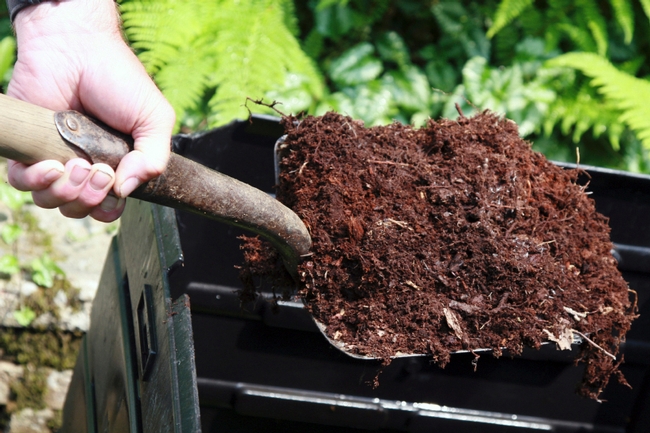
To the many benefits of composting, add another: water conservation. When compost is added to bare soils as a thin layer, it is an effective barrier against evaporation of soil moisture, a practice called top- or side-dressing. Compost also reduces plants' needs for water by increasing how much water can be held by the soil - only a 5% increase in organic material quadruples the soil's water holding capacity.1
[A] 2000 study … found that increasing the water holding capacity of the soil by adding compost helped all crops during summer droughts by reducing periods of water stress. The amount of water in … 8 inches … of the compost amended soil increased to 1.9 inches compared with 1.3 inches in un-amended soil. Since vegetables require 1 inch of water a week, at field capacity, the compost amended soil held a 2-week supply of water.2
Compost is the result of a process whereby a large volume of organic matter is rapidly decomposed into a smaller volume that is then used to amend the soil. Soil particles occur in aggregates or clumps, unless they have a high amount of sand particles that do not hold together well. Soil structure refers to the arrangement of sand, silt and clay particles into larger aggregates.3 One can assess the soil structure for their home or community garden by doing the soil-ribbon test and the soils-sedimentation test. This video from Kansas State University tells you how to assess your soil texture by feel. The bottom line is that amending the soil with compost improves its structure, which significantly affects how well it holds water.
Compost is decomposed organic matter that has stabilized, yet, still continues decomposing, though, at a slower rate. The organisms that break down organic matter release glue-like substances that bind soil particles into crumbly aggregates. These irregularly shaped aggregates have air-spaces between them and can be penetrated and occupied by water, nutrients, and plants' roots. Soils rich in organic material have a sponge-like quality that holds water and, thus, plants growing in them have lower water needs.4 In sandy soils with poor water retention, compost improves the soil's water holding capacity by improving soil structure ie., aggregate stability.
Unlike sandy soils, clay soils are characterized by small spaces between the small clay particles. Clay soils have good water retention capacity, however, the spaces in between the particles can fill with water quickly, excluding oxygen and nutrients, and, essentially, drowning the plants. Water saturation in clay soils may also cause soil runoff because those soils cannot hold more water, but, adding compost aerates clay soils and increases its capacity to hold water, oxygen, and nutrients needed for healthy plant growth.
Ultimately, regularly amending with compost lightens clay soils, thus, reducing run-off, and increases the water holding capacity of sandy soils, hence, reducing the need for water. Adding compost as a thin mulch layer over bare soils reduces water evaporation, while also reducing the need for water by garden and farm raised plants. Top-dressing with compost in combination with a thin top-layer of straw mulch in food-growing areas, or a thin woodchip mulch in ornamental garden areas, can reduce plants' water needs around their roots even more, where water is needed the most.
1 Compost Fundamentals, Compost Benefits and Uses. Washington State University, Whatcom County Extension. Accessed on 28 January 2015.
2 M. Charles Gould. Compost increases the water holding capacity of droughty soils. Michigan State University Extension. Accessed on 28 January 2015.
3 Dennis R. Pittenger, ed., California Master Gardener Handbook (University of California Agriculture and Natural Resources, 2002), 36.
4 For the Gardener: Building Fertile Soil. Center for Agroecology and Sustainable Food Systems, University of California, Santa Cruz (Santa Cruz, CA: University of California, no date provided).